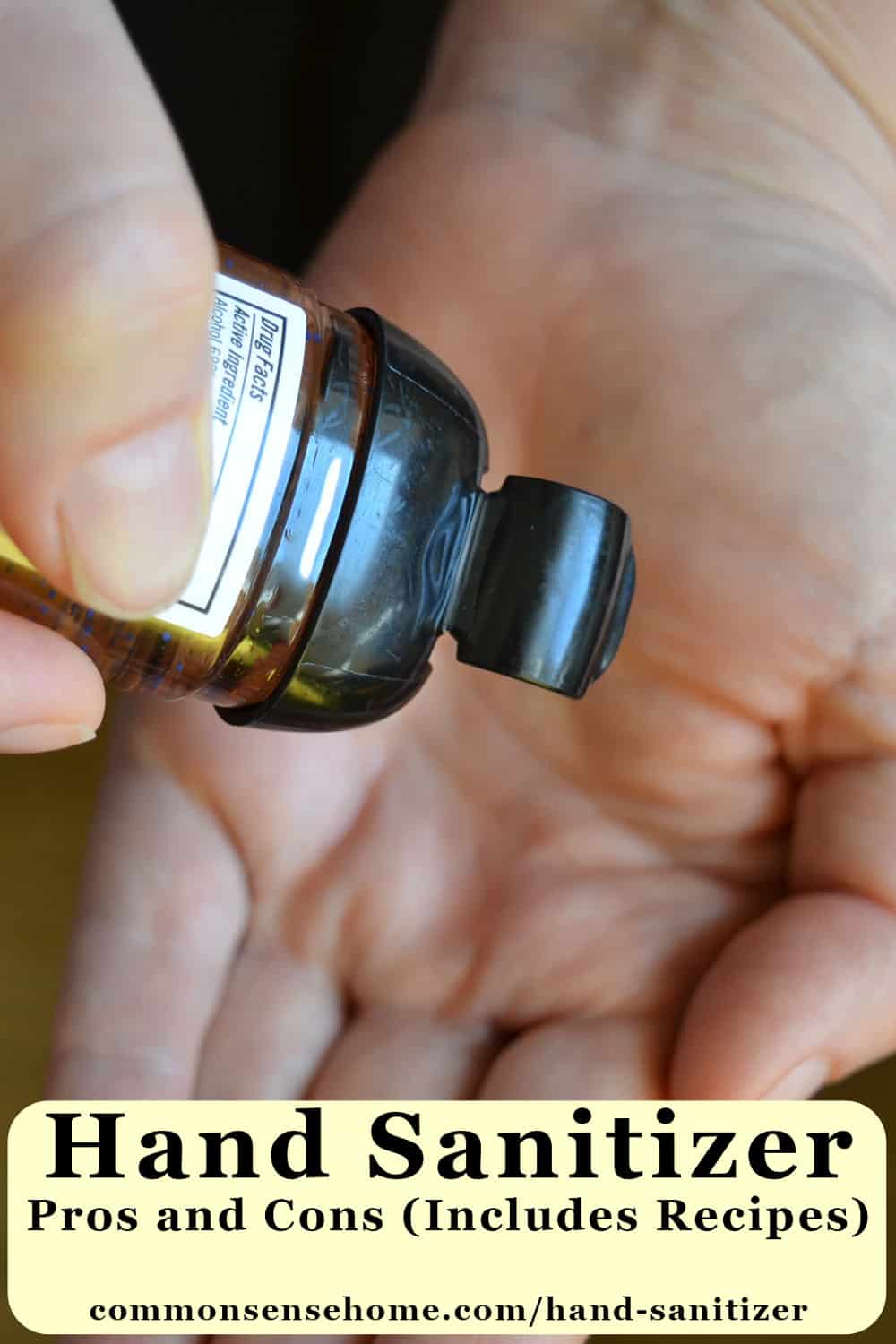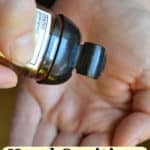Hand Sanitizer – Pros and Cons for Usage (Includes Recipes)
In this article, we’ll look at how hand sanitizer works (and when it doesn’t), the right way to use it, and share some simple recipes.

How does hand sanitizer work?
Alcohol based hand sanitizer (ABHS) kills microbes by disrupting their function. They get a fluid imbalance, bust open and die. (“Cottonmouth” from booze, microbe style, where your whole body is a “mouth”.)
Specifically:
The antimicrobial activity of alcohols can be attributed to their ability to denature and coagulate proteins. The microorganism’s cells are then lysed, and their cellular metabolism is disrupted. Alcohol solutions containing 60% to 95% alcohol are most effective. Notably, higher concentrations are less potent because proteins are not denatured easily in the absence of water.
From Alcohol Sanitizer, Nina A. Gold; Usha Avva; The National Center for Biotechnology Information
Ethanol seems to work best against viruses, whereas propanols (like isopropyl alcohol) seem to be more effective against bacteria.
Under the right conditions, ABHS quickly reduce the number of microbes on the skin and eliminate all types of germs.
Note that 100% alcohol isn’t better than 60-95% alcohol. You need other liquid to get a fluid imbalance in the microbes. Straight alcohol dries out skin, and evaporates too quickly to evenly coat hands.
That’s why sanitizers contain emollients, like aloe vera gel, which help soften the skin.
What They Don’t Kill
While hand sanitizers can help prevent the spread of disease, they are not as effective hand washing, especially against certain infections.
Protozoan cysts, certain non-enveloped (non-lipophilic) viruses, and bacterial spores can survive a rub down with ABHS.
The sanitizers don’t kill cryptosporidium parasite, C. difficile spores, poliovirus, polyomavirus, calicivirus (FCV), hepatitis A virus (HAV) and foot-and-mouth disease virus (FMDV).
They also don’t remove chemicals or other contaminants from your hands.
In other words – it’s best to wash hands with soap and water when available.
Why is it bad to use hand sanitizer?
When hands are visibly dirty, hand sanitizer isn’t likely to work very well. Please default to good old fashioned soap and water when hands get messy.
In healthcare settings or other locations where conditions are already “clean”, they are better at killing germs.
Another concern is antibiotic resistance, but so far, this has not been observed with alcohol based products. Specifically, antibacterial products containing triclosan should be avoided.
Overuse of hand sanitizer can dry out skin and disrupt pH, causing cracking and peeling. Some people may be more sensitive than others.
If dry skin is an issue for you, try a gentle hand soap such as goat milk soap.
Does Hand Sanitizer Expire?
Yes, hand sanitizer can expire, since alcohol evaporates over time, making the product less effective.
Make sure your Alcohol-based Hand Sanitizer Contains at least 60% Alcohol
The Center for Disease Control and Prevention (CDC) recommends an alcohol concentration between 60–95%.
Studies show that lower concentrations are less effective at killing germs. In fact, some commercial brands with low alcohol levels simply spread the germs around on people’s hands.
See “Hand Sanitizer Alert” at The National Center for Biotechnology Information.
Would you like to save this?
If You Want to Buy Hand Sanitizer
As they say in The Hunger Games, “May the odds be ever in your favor.”
Purell Advanced Hand Sanitizer is commonly recommended, but sold out all over. The Amazon store brand sanitizer is 70% alcohol and fairly well rated. Hopefully production will catch up to demand soon.
Important Notes for Use
- Make sure your hand sanitizer has at least 60% alcohol.
- Apply product to palm of one hand and rub the product over both hands, covering all surfaces.
- Keep rubbing until the product dries completely. This is an important step in killing the microbes.
- Don’t wipe off the product before it dries, as this limits effectiveness.
How to Make Hand Sanitizer
You can make hand sanitizer with rubbing alcohol and aloe vera gel. A few drops of essential oils boosts effectiveness.
Vodka is typically 80 proof, which means that it is 40 percent alcohol. This is not high enough to effectively kill microbes.
Recipes adapted from The Herbal Academy.
Ingredients
- 6.5 fl oz 91% isopropyl alcohol
- 3 tbsp (1.5 fl oz) Aloe vera gel (thick, also known as aloe jelly)
- 20 drops essential oil (optional)
OR
- 5.5 fl oz 190 proof (95%) grain alcohol
- 5 tbsp (2.5 fl oz) Aloe vera gel (thick, also known as aloe jelly)
- 20 drops essential oil (optional)
Some good essential oils to use include:
- tea tree
- lavender
- peppermint
- eucalyptus
For children under 10, do not use peppermint or eucalyptus oil, and reduce amount of essential oils to 10 drops.
Directions
Mix aloe vera and essential oils (if using) in a glass pint jar. Add alcohol, cover and shake until well mixed.
Label and store out of direct sunlight. Keep out of reach of children.
To use, shake well and transfer a portion into a glass dropper bottle. Squirt a few drops into the palm of one hand and rub over both hands until dry.
Related Posts
We have over 100 natural health and home remedies articles on the site, including:
Emergency Medical Kit List – Build Your Own Custom First Aid Kit
E Coli – What is it, and Why so many recalls?
Herbal Antibiotics – 15 Natural Ways to Fight Infection
6 Benefits of Cold Showers, the Cheap and Easy Health Tonic
I hope you found this post helpful to explain what hand sanitizer does and doesn’t do. Stay safe out there!


Found and puchased Aloe Vera (99.8% pure) this is not “gel”…Will it still work?
With a thinner aloe vera product, skip the essential oils. The thicker consistency is needed to keep the oils evenly dispersed.